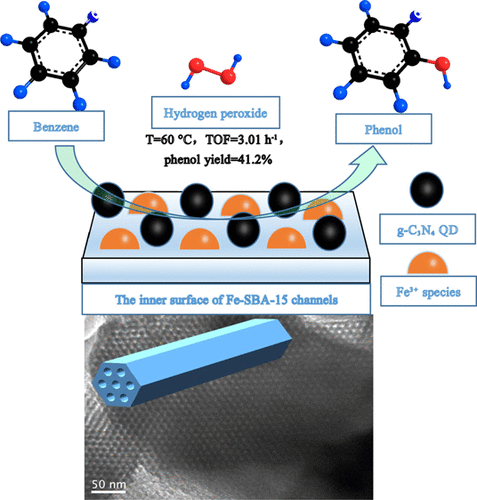当前位置:
X-MOL 学术
›
Ind. Eng. Chem. Res.
›
论文详情
Our official English website, www.x-mol.net, welcomes your
feedback! (Note: you will need to create a separate account there.)
Enhanced Hydroxylation of Benzene to Phenol with Hydrogen Peroxide over g-C3N4 Quantum Dots-Modified Fe-SBA-15 Catalysts: Synergistic Effect Among Fe Species, g-C3N4 QDs, and Porous Structure
Industrial & Engineering Chemistry Research ( IF 3.8 ) Pub Date : 2021-09-14 , DOI: 10.1021/acs.iecr.1c03378 Lizhen Qin 1 , Zhengyu Feng 2 , Qing Zhang 2 , Huihui Mao 2 , Fei Cheng 2 , Shaoming Shi 2
Industrial & Engineering Chemistry Research ( IF 3.8 ) Pub Date : 2021-09-14 , DOI: 10.1021/acs.iecr.1c03378 Lizhen Qin 1 , Zhengyu Feng 2 , Qing Zhang 2 , Huihui Mao 2 , Fei Cheng 2 , Shaoming Shi 2
Affiliation

|
g-C3N4 quantum dots (QDs) attract considerable attention due to its remarkable applications in various fields such as catalysis, ion detection, and biosensors. Herein, the inner surface of the hexagon channels of Fe-SBA-15 was adorned by g-C3N4 QDs to enhance direct hydroxylation of benzene with H2O2 to afford phenol. The crystal texture, porous properties, inner structure, morphology, elemental distribution, chemical composites, and bonding energy of the synthesized CN-QDs/Fe-SBA-15 were thoroughly analyzed and characterized using X-ray diffraction, N2 adsorption–desorption, transmission electron microscopy (TEM), scanning electron microscopy–energy-dispersive X-ray spectroscopy, high-resolution transmission electron microscopy, high-angle annular dark-field scanning TEM, X-ray photoelectron spectroscopy, and UV–vis and Fourier-transform infrared spectroscopies. The catalytic performance of the synthesized g-C3N4 QD-decorated Fe-SBA-15 was explored for one-step direct oxidation of benzene, with H2O2 as a green oxidant to obtain phenol. The structural characterization and catalytic investigation revealed that benzene molecules were adsorbed on the surface of CN-QDs by noncovalent interactions and activated by the terminal groups, that is, N-defects/C–OH present on the edges of CN-QDs. Then, the activated benzene was attacked by the hydroxyl radical generated by iron-peroxo-capturing hydrogen ion to produce phenol. The mesoporous structure of Fe-SBA-15 not only deals with the stability and aggregation of g-C3N4 QDs but also ensures the uniform dispersion of Fe species on the inner surface of the channel. The maximum yield of phenol obtained was 41.2% in this catalytic system, which is crucially dependent on the synergic effect between g-C3N4 QDs and Fe-SBA-15.
中文翻译:

在 g-C3N4 量子点修饰的 Fe-SBA-15 催化剂上用过氧化氢增强苯羟基化为苯酚:Fe 物种、g-C3N4 量子点和多孔结构之间的协同效应
gC 3 N 4量子点(QDs)因其在催化、离子检测和生物传感器等各个领域的卓越应用而备受关注。在此,Fe-SBA-15 六边形通道的内表面装饰有 gC 3 N 4 QDs,以增强苯与 H 2 O 2 的直接羟基化反应,得到苯酚。使用 X 射线衍射、N 2对合成的 CN-QDs/Fe-SBA-15 的晶体结构、多孔性质、内部结构、形貌、元素分布、化学复合物和键能进行了全面分析和表征。吸附-解吸、透射电子显微镜 (TEM)、扫描电子显微镜-能量色散 X 射线光谱、高分辨率透射电子显微镜、高角度环形暗场扫描 TEM、X 射线光电子能谱和 UV-vis和傅里叶变换红外光谱。研究了合成的 gC 3 N 4 QD 修饰的 Fe-SBA-15 对苯一步直接氧化的催化性能,H 2 O 2作为绿色氧化剂得到苯酚。结构表征和催化研究表明,苯分子通过非共价相互作用吸附在 CN-QDs 表面,并被端基活化,即 CN-QDs 边缘存在的 N-缺陷/C-OH。然后,活化的苯受到铁过氧捕获氢离子产生的羟基自由基的攻击,生成苯酚。Fe-SBA-15 的介孔结构不仅解决了 gC 3 N 4 QDs的稳定性和聚集问题,而且保证了 Fe 物种在通道内表面的均匀分散。在该催化体系中,苯酚的最大产率为 41.2%,这主要取决于 gC 3 N 4之间的协同作用。 QD 和 Fe-SBA-15。
更新日期:2021-09-29
中文翻译:

在 g-C3N4 量子点修饰的 Fe-SBA-15 催化剂上用过氧化氢增强苯羟基化为苯酚:Fe 物种、g-C3N4 量子点和多孔结构之间的协同效应
gC 3 N 4量子点(QDs)因其在催化、离子检测和生物传感器等各个领域的卓越应用而备受关注。在此,Fe-SBA-15 六边形通道的内表面装饰有 gC 3 N 4 QDs,以增强苯与 H 2 O 2 的直接羟基化反应,得到苯酚。使用 X 射线衍射、N 2对合成的 CN-QDs/Fe-SBA-15 的晶体结构、多孔性质、内部结构、形貌、元素分布、化学复合物和键能进行了全面分析和表征。吸附-解吸、透射电子显微镜 (TEM)、扫描电子显微镜-能量色散 X 射线光谱、高分辨率透射电子显微镜、高角度环形暗场扫描 TEM、X 射线光电子能谱和 UV-vis和傅里叶变换红外光谱。研究了合成的 gC 3 N 4 QD 修饰的 Fe-SBA-15 对苯一步直接氧化的催化性能,H 2 O 2作为绿色氧化剂得到苯酚。结构表征和催化研究表明,苯分子通过非共价相互作用吸附在 CN-QDs 表面,并被端基活化,即 CN-QDs 边缘存在的 N-缺陷/C-OH。然后,活化的苯受到铁过氧捕获氢离子产生的羟基自由基的攻击,生成苯酚。Fe-SBA-15 的介孔结构不仅解决了 gC 3 N 4 QDs的稳定性和聚集问题,而且保证了 Fe 物种在通道内表面的均匀分散。在该催化体系中,苯酚的最大产率为 41.2%,这主要取决于 gC 3 N 4之间的协同作用。 QD 和 Fe-SBA-15。











































 京公网安备 11010802027423号
京公网安备 11010802027423号